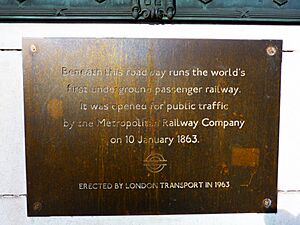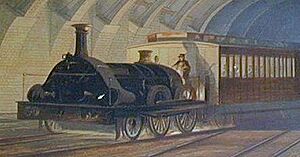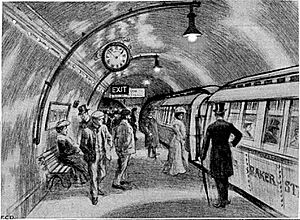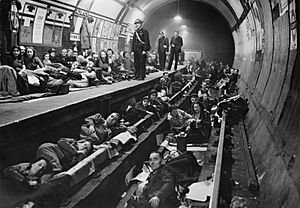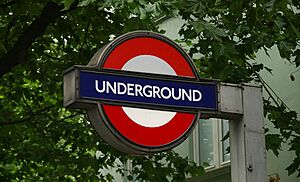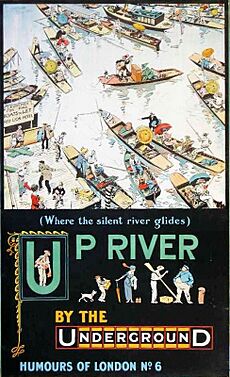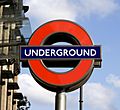London Underground facts for kids
Quick facts for kids London Underground |
|
|---|---|
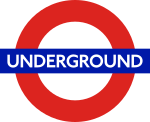 Why London Underground is nicknamed The Tube.jpg |
|
| Info | |
| Locale | |
| Transit type | Rapid transit |
| Number of lines | 11 |
| Number of stations | 272 served (262 owned) |
| Operation | |
| Began operation | January 10, 1863 |
| Operator(s) | London Underground Limited |
| Reporting marks | LT (National Rail) |
| Technical | |
| System length | 402 km (250 mi) |
| Track gauge |
|
| Electrification | Fourth rail, 630 or 750VDC |
| Average speed | 33 km/h (21 mph) |
| Part of a series of articles on The Tube |
|
|---|---|
| Overview |
|
The London Underground is a famous public transport system in London, England. People often call it the Underground or the Tube. It's a rapid transit system that helps millions of people travel around Greater London and nearby areas. It has 11 lines and 272 stations.
The Underground first opened on 10 January 1863. This made it the world's first underground passenger railway. The first trains were powered by steam, but the system later switched to electric trains.
It got the nickname "the Tube" because of its deep, circular tunnels that look like tubes. However, only 45% of the system is actually underground. Much of the track in London's outer areas runs on the surface.
The system is famous for its logo, called the roundel (a red circle with a blue bar), and its unique map. The Tube map, designed by Harry Beck in 1931, is a design classic. It simplifies the network to make it easy for passengers to understand.
Today, the Underground is run by Transport for London (TfL). Passengers use contactless bank cards or a special smartcard called an Oyster card to pay for their journeys.
Contents
History of the London Underground
How the Tube Began
In the 1830s, London was growing fast and its streets were very crowded. The idea of an underground railway was suggested to connect the city's main train stations. In 1863, the Metropolitan Railway opened. It was the world's first underground railway and was a huge success. On its first day, it carried 38,000 passengers.
These first tunnels were built using a method called "cut-and-cover." Workers dug a large trench, built the railway inside it, and then covered it over. These lines are just below the surface and are now part of the Circle, District, Hammersmith & City, and Metropolitan lines.
Later, new technology allowed for digging deeper tunnels. These were circular and gave the Underground its "Tube" nickname. The first deep-tube line, the City & South London Railway, opened in 1890. It used electric trains, which were much cleaner than the smoky steam trains.
Growing and Coming Together
In the early 20th century, different private companies owned the various Tube lines. An American businessman named Charles Yerkes bought several of these lines. He formed the Underground Electric Railways Company of London (UERL). The UERL opened the Bakerloo, Piccadilly, and Hampstead (now part of the Northern) lines.
The companies started working together. They created joint maps and signs, including the famous roundel logo, to make travel easier. By 1933, most of London's underground, bus, and tram services were combined to form London Transport. This made the system much more unified.
The Tube in World War II
During the Second World War, many Tube stations were used as air-raid shelters. Thousands of people slept on the platforms to stay safe from bombs. The government even turned some unfinished tunnels into secret factories.
After the war, work continued to expand the network. The Central line was extended into east and west London.
Modern Times
In 1968, the Victoria line opened. It was a new kind of Tube line, with trains that drove themselves automatically. In 1979, the Jubilee line opened, named for Queen Elizabeth II's Silver Jubilee.
A serious fire at King's Cross station in 1987 led to major safety improvements. Wooden escalators were replaced with metal ones, and smoking was banned everywhere on the Underground.
In 2000, Transport for London (TfL) was created to run all of London's transport. TfL has invested a lot of money to modernise the Tube. This includes new trains, better signalling, and making more stations accessible for people with disabilities. In 2021, the Northern line was extended to serve the Battersea area.
The Tube's Lines and Tunnels
The London Underground has two types of lines: sub-surface lines and deep-tube lines.
- Sub-surface lines are just below the ground. The tunnels are large and rectangular. The trains are a similar size to those on mainline railways. The sub-surface lines are the Circle, District, Hammersmith & City, and Metropolitan lines.
- Deep-tube lines are much deeper underground in circular tunnels. The trains are smaller and have a curved shape to fit inside the "tube." The deep-tube lines are the Bakerloo, Central, Jubilee, Northern, Piccadilly, Victoria, and Waterloo & City lines.
The total length of the track is 402 kilometres (250 mi). Despite its name, 55% of the system is actually on the surface, not in tunnels.
List of Tube Lines
The Underground has 11 lines, each with its own name and colour on the map.
| Name | Map colour |
Opened | Type | Length (km) | Stations | Current rolling stock |
|---|---|---|---|---|---|---|
| Bakerloo line | Brown | 1906 | Deep tube | 23.2 | 25 | 1972 Stock |
| Central line | Red | 1900 | Deep tube | 74.0 | 49 | 1992 Stock |
| Circle line | Yellow | 1871 | Sub surface | 27.2 | 36 | S7 Stock |
| District line | Green | 1868 | Sub surface | 64.0 | 60 | S7 Stock |
| Hammersmith & City line | Pink | 1864 | Sub surface | 25.5 | 29 | S7 Stock |
| Jubilee line | Grey | 1979 | Deep tube | 36.2 | 27 | 1996 Stock |
| Metropolitan line | Magenta | 1863 | Sub surface | 66.7 | 34 | S8 Stock |
| Northern line | Black | 1890 | Deep tube | 58.0 | 52 | 1995 Stock |
| Piccadilly line | Dark blue | 1906 | Deep tube | 71.0 | 53 | 1973 Stock |
| Victoria line | Light blue | 1968 | Deep tube | 21.0 | 16 | 2009 Stock |
| Waterloo & City line | Turquoise | 1898 | Deep tube | 2.5 | 2 | 1992 Stock |
Keeping the Tube Cool
The tunnels can get very hot, especially in the summer. This is because heat from the trains' brakes and engines has built up over many years. TfL is working on ways to cool the Tube down.
Some stations use cool groundwater to lower the temperature. Newer trains on the sub-surface lines have air-conditioning. The next generation of deep-tube trains, called the 'New Tube for London', will also have air-conditioning.
Travelling on the Tube
Tickets and Fares
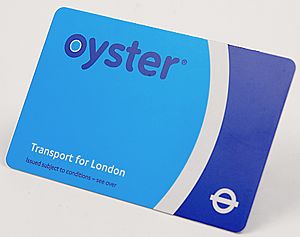
To travel on the Underground, you need a valid ticket. Most people use a contactless payment card or an Oyster card. An Oyster card is a plastic smartcard that you can top up with money.
Fares are based on a zone system. London is divided into 9 zones. Zone 1 is in the centre, and the zones go up as you travel further out. The price of your journey depends on how many zones you travel through. Using an Oyster or contactless card is cheaper than buying a paper ticket.
Hours of Operation
The Tube usually runs from about 5:00 in the morning until around midnight. On Friday and Saturday nights, a 24-hour service called the Night Tube runs on the Victoria, Jubilee, Central, Northern, and Piccadilly lines.
The Underground does not run on Christmas Day and has a limited service on other public holidays.
Accessibility
When the Underground was first built, accessibility for people with mobility issues was not a priority. Today, TfL is working to make more stations step-free. This means providing lifts and ramps so that people in wheelchairs or with pushchairs can use the Tube more easily.
Newer stations, like those on the Jubilee Line Extension, were designed to be fully accessible. The newest trains also have dedicated spaces for wheelchairs and better information systems for passengers.
Design and Art on the Underground
The Tube Map
The Tube map is one of the most famous transport maps in the world. Before 1933, maps were geographically accurate, which made them look messy and hard to read.
In 1931, an engineering draftsman named Harry Beck designed a new map. He realised that passengers didn't need to know the exact geography. They just needed to know how to get from one station to another. He drew the lines as straight lines with 45-degree or 90-degree turns. This made the map much clearer. His design is still the basis for the map used today.
The Roundel Logo
The roundel (a red circle with a blue bar across the middle) is the symbol of the London Underground. It was first used in 1908 to make station names stand out on platforms.
The design was developed by Frank Pick, a transport administrator, and refined by the calligrapher Edward Johnston in 1917. Today, different coloured roundels are used for all of TfL's services, including buses and the Overground.
Architecture
Many Underground stations are famous for their architecture. In the early 20th century, architect Leslie Green designed many stations with distinctive ox-blood red tiles.
In the 1920s and 1930s, Charles Holden designed many stations in a modern Art Deco style. His designs for stations like Arnos Grove and Southgate are now considered classic examples of modernist architecture. The newer stations on the Jubilee Line Extension, designed by famous architects like Norman Foster, have a very modern, high-tech look.
Posters and Art
From its early days, the Underground has used posters to encourage people to travel. These posters were often beautiful works of art. The company hired famous artists and designers to create them.
Today, the tradition continues with Art on the Underground. This project commissions artists to create new artworks for stations across the network. You can also find poems displayed inside the train carriages as part of the Poems on the Underground project.
Images for kids
-
A 1959 Stock train at Barons Court.
-
An overcrowded Northern line train during peak hours.
See also
 In Spanish: Metro de Londres para niños
In Spanish: Metro de Londres para niños



